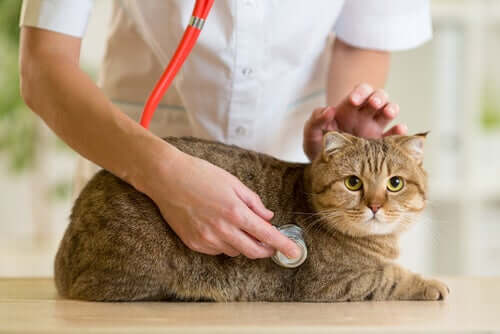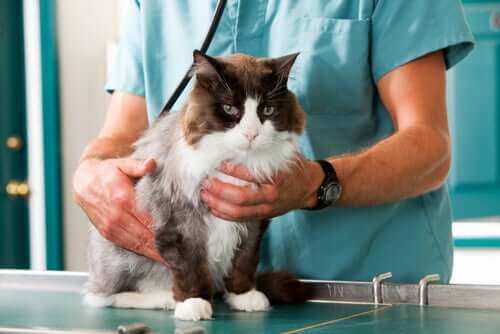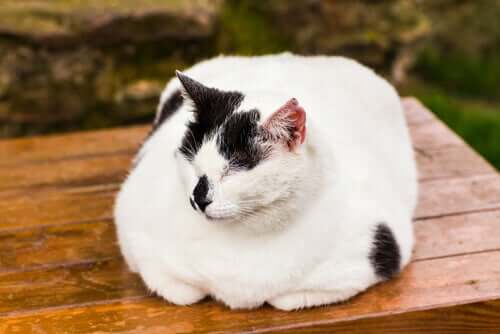Feline Diabetes: Causes, Symptoms, and Treatment

Diabetes is a disease that affects millions of people. It’s characterized by high concentrations of glucose in the blood due to a defect in the production of insulin. The latter is a hormone responsible for transporting glucose into cells. Apparently, cats can suffer from this too, and we call it feline diabetes.
An alarming number of cats are starting to be affected by the disease. The consequences of not detecting diabetes on time can vary from weight gain, vomiting, dehydration, severe depression, coma, and even death. Therefore, in this article, we’ll offer you a series of facts to help you keep your dear pets healthy.
Causes and symptoms of feline diabetes
Diabetes, scientifically called “diabetes mellitus”, manifests itself in cats in a similar way as it does in people. We must pay special attention to the symptoms that our pet may experience in order to treat them as soon as possible.

Here’s a non-exhaustive list that can help us tell if our cat has diabetes:
- Increased thirst and urine production. These are the most common and visible symptoms.
- Weight loss or gain with polyphagia. Polyphagia is defined as the imperious and uncontrollable feeling of hunger that occurs during certain diseases.
- Hair loss.
- Cataracts – although this symptom is more frequent in dogs than in cats.
- Urinary tract infection.
- Weakness.
- The smell of acetone and bad breath. This is a symptom derived from ketosis, a metabolic process caused by a carbohydrate deficit in which acetone and derived compounds are released into the blood and urine.
All these symptoms are derived from the animal’s inability to use glucose as a source of energy. We must take into account that feline diabetes manifests itself especially from the age of six and that males are more predisposed to suffer from it.

One of the main risk factors is obesity. An overweight cat or person will tend to have a higher amount of insulin in their blood than normal. Another risk factor is having an endocrine disease, such as acromegaly, a condition caused by excessive secretion of the growth hormone.
Prevention and Treatment
Diabetes is a treatable and preventable disease. However, if ignored, it can cause serious consequences or even lead to death. The most recent studies show that between 17 and 52% of cats are or have been obese. A sedentary life in a home, coupled with an unbalanced diet, is often the main cause of this problem.
Treatment for diabetes will depend on how early the vet diagnoses the disease. With diabetes, the sooner you recognize the signs, the sooner you should seek veterinary attention and the sooner you’ll be able to get your cat on insulin.
In the case of diabetes, prevention and treatment go hand in hand. Moreover, studies have shown that a change in a diabetic cat’s diet has led to a readjustment in their insulin levels. Therefore, we can say that providing our cat with a balanced diet is the best way to prevent and manage this disease.
Another treatment is insulin injections. Even though they may sound intimidating, many cat parents get used to them quickly and feel very comfortable with the process. Once your vet shows you how to do it, it’s easy, as the needle is really small.

Moreover, our vets’ recommendations in this regard are essential when treating feline diabetes. The most common form of treatment is the administration of slow-acting insulin doses twice a day.
Veterinarian doctors recommend two doses because a feline metabolism is faster than a human’s. Therefore, it’s important to use a type of insulin that’s specifically for animals and not the artificial insulin used by humans.
The kinds of insulin used for animals are of bovine or porcine origin. However, cats respond unpredictably to external supplies of insulin, so veterinarian experience and preference will be essential for the treatment’s success.
In summary
With appropriate care and treatment, cats with feline diabetes can live a long, healthy life. However, they’ll require frequent trips to the vet to regulate blood sugar. Having a diabetic cat is also a big commitment, as it requires loving pet parents who can give twice-a-day injections of insulin (especially when you go on vacation).
If you have any questions or concerns, you should always visit or call your vet. As we always say, they’re the best resource available to ensure the health and well-being of your pets.